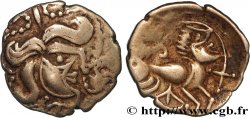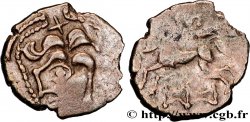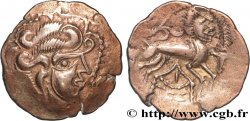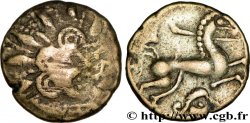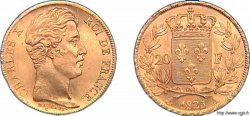bga_325312 - GALLIEN - ARMORICA - OSISMII (Region die Carhaix - Finistère) Statère composite en bas électrum, à la chevelure rayonnante, DT. 3625
Nicht verfügbar.
Artikel auf unserem Online-Shop verkauft (2015)
Preis : 2 650.00 €
Artikel auf unserem Online-Shop verkauft (2015)
Preis : 2 650.00 €
Type : Statère composite en bas électrum, à la chevelure rayonnante, DT. 3625
Datum: c. 80-50 AC.
Name der Münzstätte / Stadt : Brest (29)
Metall : Elektrum
Durchmesser : 20 mm
Stempelstellung : 11 h.
Gewicht : 6,54 g.
Seltenheitsgrad : R3
Kommentare zum Erhaltungszustand:
Monnaie en très bas or,avec des types de droit et de revers assez bien centrés et de frappe vigoureuse. Métal de faible aloi, avec un avers comme brossé et un revers plus homogène avec une teinte blanchâtre
Vorderseite
Titulatur der Vorderseite ANÉPIGRAPHE.
Beschreibung Vorderseite Tête à droite, la chevelure rayonnante.
Rückseite
Titulatur der Rückseite ANÉPIGRAPHE.
Beschreibung Rückseite Cheval galopant à droite avec un triangle au-dessus de la croupe ; un buste humain droite, entre les jambes du cheval.
Kommentare
L’attribution du bga_228343 (classé Namnète en accord avec le Nouvel Atlas) nous semble désormais à revoir en faveur des Osismes.
Cette série est bien connue, mais ses spécimens semblent peu nombreux ! Dès 1873, E. Hucher publie le dessin d’un statère de cette série (Tome I, fig. n° 87) qui serait celui du MAN. Bien que l’iconographie s’en distingue nettement, il était alors associé aux monnayages pictons et santons, probablement en rapport avec la facture et le type de métal utilisé. L’exemplaire de la BN est indiqué comme provenant de la Loire à Angers (Maine-et-Loire).
Bien que très rare, on peut remarquer que le petit buste humain à droite entre les jambes du cheval (probablement une dégénérescence de l’hippophore) est une constante alors que le triangle au-dessus de la croupe du cheval n’est pas systématique et il en va de même pour la rouelle devant le poutrail
Toutes variantes confondues, ce statère serait le quatrième exemplaire publié, après celui de la BN qui illustre le Nouvel Atlas (DT. 3625), l’exemplaire du MAN, décrit comme “inaccessible” et le bga_228343 (qui, bien que dans un piètre état, a le mérite d’exister)
.
The attribution of bga_228343 (classified as Namnete in accordance with the New Atlas) now seems to us to be reviewed in favor of Osisms.
This series is well known, but its specimens seem few in number! As early as 1873, E. Hucher published the drawing of a stater from this series (Volume I, fig. No. 87) which would be that of the MAN. Although the iconography is clearly different, it was then associated with Picton and santon coinage, probably in relation to the manufacture and the type of metal used.. The BN copy is indicated as coming from the Loire in Angers (Maine-et-Loire).
Although very rare, we can notice that the small human bust on the right between the horse's legs (probably a degeneration of the hippophore) is a constant while the triangle above the horse's rump is not systematic and the same goes for the wheel in front of the beam. All variants combined, this stater would be the fourth published copy, after that of the BN which illustrates the New Atlas (DT. 3625), the MAN copy, described as “inaccessible” and bga_228343 (which, although in poor condition, has the merit of existing)
Cette série est bien connue, mais ses spécimens semblent peu nombreux ! Dès 1873, E. Hucher publie le dessin d’un statère de cette série (Tome I, fig. n° 87) qui serait celui du MAN. Bien que l’iconographie s’en distingue nettement, il était alors associé aux monnayages pictons et santons, probablement en rapport avec la facture et le type de métal utilisé. L’exemplaire de la BN est indiqué comme provenant de la Loire à Angers (Maine-et-Loire).
Bien que très rare, on peut remarquer que le petit buste humain à droite entre les jambes du cheval (probablement une dégénérescence de l’hippophore) est une constante alors que le triangle au-dessus de la croupe du cheval n’est pas systématique et il en va de même pour la rouelle devant le poutrail
Toutes variantes confondues, ce statère serait le quatrième exemplaire publié, après celui de la BN qui illustre le Nouvel Atlas (DT. 3625), l’exemplaire du MAN, décrit comme “inaccessible” et le bga_228343 (qui, bien que dans un piètre état, a le mérite d’exister)
.
The attribution of bga_228343 (classified as Namnete in accordance with the New Atlas) now seems to us to be reviewed in favor of Osisms.
This series is well known, but its specimens seem few in number! As early as 1873, E. Hucher published the drawing of a stater from this series (Volume I, fig. No. 87) which would be that of the MAN. Although the iconography is clearly different, it was then associated with Picton and santon coinage, probably in relation to the manufacture and the type of metal used.. The BN copy is indicated as coming from the Loire in Angers (Maine-et-Loire).
Although very rare, we can notice that the small human bust on the right between the horse's legs (probably a degeneration of the hippophore) is a constant while the triangle above the horse's rump is not systematic and the same goes for the wheel in front of the beam. All variants combined, this stater would be the fourth published copy, after that of the BN which illustrates the New Atlas (DT. 3625), the MAN copy, described as “inaccessible” and bga_228343 (which, although in poor condition, has the merit of existing)








 Berichten über einen Fehler
Berichten über einen Fehler Die Seite drucken
Die Seite drucken Teilen meiner Auswahl
Teilen meiner Auswahl Stellen Sie eine Frage
Stellen Sie eine Frage Einlieferung/Verkauf
Einlieferung/Verkauf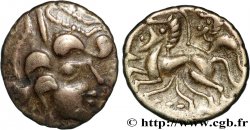
 Details
Details